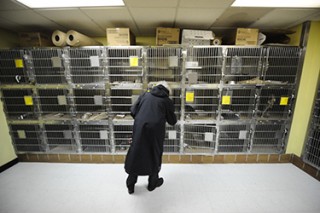Homeward Bound No Longer
January 26, 2009
The recent economic crisis is affecting more than just humans-many pets are falling victim to hard times because their owners can no longer afford to care for them.
In the past three months, Chicago Animal Care and Control, 2741 S. Western Ave., has seen an increase in animals entering the system, but a decrease in adoptions.
“The most dramatic change is fewer people [are] coming to claim [their] animals with chips and tags [pet identification used to contact the owner if found],” said Charles Craft, director of programs and services at Animal Care and Control.
Due to the recent spike in home foreclosures, the most frequent cases found at the center are abandoned animals and people giving them up because they’re moving. In some cases, owners are just leaving pets behind in abandoned buildings, Craft said.
Although the center is experiencing a deficit in adoptions, it has increased its efforts to transfer animals to other shelters and rescue groups.
“[It] indicates that there are areas in the city that haven’t been impacted so much by the economy,” Craft said.
The transferring process began in 2002. The center currently has relationships with 108 organizations that are local, such as P.A.W.S. and the Anti Cruelty Society. It also extends transfers throughout the state, Wisconsin, Indiana and Michigan.
Last year the center took in about 24,000 animals: 2,300 were adopted, 1,300 were redeemed by their owners, 13,000 were euthanized and 4,300 were transferred.
“We have more impact by getting dogs out to other shelters,” said Alex Shibicky, a five-year volunteer.
Shibicky treats the adoptions similar to a business. All lost, stray and abandoned animals found go directly to the center, in addition to the ones dropped off by people.
“We have an inventory of animals coming to us; we’re the distribution center, and we’re looking for retail outlets,” Shibicky said.
The retail outlets would be the animal shelters and rescue groups that Animal Care and Control transfers out to. This new approach is part of the many changes the center has made over the years.
Chicago Animal Care and Control is a department of the city of Chicago and was originally designed as a catch-and-kill facility at its inception in 1984.
“It was never designed to do what it does now,” Craft said.
The center now accommodates adoptions, transfers its dogs and cats to other shelters, provides full veterinary services and takes in cats. It also provides free or low-cost spay and neuter services to Chicago residents via its mobile unit, the Animobile, which was donated by the Chicago Wolves hockey team.
The center can diversify its operations and function more effectively thanks to outside help. Friends of Animal Care and Control is a nonprofit organization that assists the center and helps beyond the city’s capabilities.
Currently, the nonprofit is working with the center on fine-tuning its needs assessment and presenting the city with renovation plans for the facility.
“We’re hopeful it’ll be before the end of the month,” Craft said.
The facility was state of the art when it was built 25 years ago, but it needs updates. The center was not equipped to hold cats when it was built.
The major work needed is the improvement of air circulation and the sanitation system in the dog pavilion, said seven-year volunteer Kathy Wilson.
“We really want to improve the health of the animals,” Wilson said.
Outbreaks of kennel cough, a cold for dogs, is a big concern because it’s very contagious and caused by poor air circulation. If the dogs are infected, they are put into medical treatment for at least 10 days, “and that’s 10 days they aren’t on the adoption floor,” Wilson said.
Getting animals out alive is the center’s main priority. Unlike the numerous animal shelters around the city, Chicago Animal Care and Control has an open-door policy where no animal is turned away, which leads to its high volume. But it also has the unavoidable duty of euthanizing the animals.
Euthanasia is considered on an individual basis. The animals put down are temperamental, too old or too sick to be taken care of by the center any longer.
The fact the center is a kill shelter leads to a high volunteer turnover rate, Wilson said.
“It’s not the easiest place in the world to volunteer,” she said. “But I’m so addicted to it, because every time I come here I might be saving a life.”
Volunteers walk, train and socialize dogs and cats. The volunteers are also the ones who introduce potential owners to the adoptable pets.
“We rely on our volunteers 100 percent,” Craft said.
If the volunteers don’t walk the dogs, then the dogs remain in their kennels. Walks are necessary for the dogs to relieve themselves otherwise the feces remain in the kennels. Due to minimal staffing and other duties, the staff does not have enough time to walk the dogs.
“What we need more than anything is volunteers,” Shibicky said.
At the no-kill shelter P.A.W.S., some dogs get walked five times a day while some at Animal Care and Control do not get walked once a day, he said. The reason for this is that P.A.W.S. has an abundance of volunteers.
For more information, visit CityOfChicago.org and search under departments.








